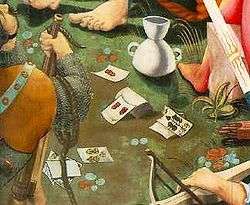Karnöffel
Karnöffel is a trick-taking card game which probably came from the upper-German language area in Europe in the first quarter of the 15th century. It first appeared listed in a municipal ordinance of Nördlingen, Bavaria, in 1426 among the games that could be lawfully played at the annual city fête.[2] This makes the game the oldest identifiable European card game in the history of playing cards with a continuous tradition of play down to the present day.[3]
 | |
| Origin | Germany |
|---|---|
| Type | Trick-taking |
| Players | 2-8 |
| Cards | 48 |
| Deck | German |
| Play | Clockwise |
| Card rank (highest first) | K Q J 10 9 8 7 6 5 4 3 2 |
| Related games | |
| Kaiserspiel, Knüffeln, Alkort, Treikort, Brus, Bruus, Bräus, Styrivolt, Watten, Vorms | |
Karnöffel
The earliest substantial reference to Karnöffel is a poem by Meissner, written in or before 1450. In medieval times, the word also meant inguinal hernia.[4]
Karnöffel had a suit in which some cards had a higher priority than cards in other suits, which indicates that it might be a possible precursor to the trump suit of Tarot. Karnöffel utilizes a deck of 48 cards, Aces having been removed from German and Swiss playing cards during the 14th or early 15th century.[5] The original game was played with German-suited cards; its present-day descendants are played with Swiss-suited (Kaiserspiel) or French-suited cards (Knüffeln, Styrivolt, Brus/Bräus).
One derivative of the game using Swiss-suited cards still played around Stans and in the Engelberg valley in the canton of Nidwalden in Switzerland under the name Kaisern, Kaiserspiel or Kaiserjass, though it is not related to Jass.[6] It is a five-card partnership game of which each deal is won by the first side to win three tricks.
Other living descendants, using 48 French-suited cards, are Knüffeln, played in Frisia in north Germany, and Styrivolt, played in the Faroe Islands.
Rules
The game was played with a 48-card pack with the following card ranking:
- King, Ober, Unter, 10, 9, 8, 7, 6, 5, 4, 3, 2 (Deuce)
Players
It was played by four players in two teams of two; the partners sitting opposite one another.
Card powers
| No. | * | Card | Description | Name | Translation |
|---|---|---|---|---|---|
| 1 | T | Trump Unter | beats all cards | Karnöffel | |
| (2) | T | Trump 7 | beats all cards apart from the Karnöffel, but only if led to a trick. In all other circumstances it is only a 7. It may not be played to the first trick. | Teufel, Böse 7 | Devil, Evil/Bad/Naughty 7 |
| 3 | T | Trump 6 | beats all other cards apart from the aforementioned two. | Papst | Pope |
| 4 | T | Trump Deuce | beats all other cards apart from the aforementioned three. | Kaiser, Hochkönig | Emperor, High King |
| The Karnöffel, Papst and Kaiser are also known as King-beaters (Kingstecher), because they are the only ones that can beat a King. | |||||
| 5 | Kings | König | King | ||
| 6 | T | Trump 3 | beats all other cards apart from the aforementioned trumps and the Kings. | Oberstecher, Barde | Ober-beater |
| 7 | Obers | ||||
| 8 | T | Trump 4 | beats all other cards apart from the aforementioned trumps and King and Ober. | Understecher, Herzog | Unter-beater, Duke |
| 7 | Unters | ||||
| 8 | T | Trump 5 | beats all other cards apart from the aforementioned trumps and King, Ober and Unter. | Farbstecher, Ritter | Suit-beater, Knight |
| The King, Ober, 10, 9 and 8 of the trump suit have no trump powers. | |||||
Playing
- The first dealer deals 5 cards to each player, one at a time. The first card is placed face up in front of the respective player, the remaining four cards stay face down.
- The lowest of the face up cards determines the trump suit for this deal. If 2 cards have the same rank, the first to be dealt decides the trump suit. Thereafter the players pick their cards up.
- The player left of the dealer leads to the first trick; the other players play in clockwise order.
- There is no requirement to follow suit. The player with the highest card of the led suit or the highest trump wins the trick and leads to the next.
- This continues until one team has taken three tricks and so won the deal.
- Players may talk to one another during the game; mutual support is actually encouraged.
- The player who led to the first trick becomes the next dealer.
References
- Parlett 2020.
- Dummett 1980, p. 184.
- Dummett 1978, p. 130.
- von Leyden, Rudolf. (1978). Karnöffel: Das Kartenspiel der Landsknechte. Vienna.
- Dummett, Michael (1980). The Game of Tarot. London: Duckworth. p. 24. ISBN 0 7156 1014 7.
- Kaiserspiel Card Game - Oxford Dictionary of Card Games, David Parlett, pg:139
Literature
- Dummett, Michael (1978). Reviews of "Der Nidwaldener Kaiserjass Und Seine Geschichte" and "Der Kaiserjass, Wie Er Heute in Nidwalden Gespielt Wird" in The Playing Card, Vol. 9, No. 4, May 1981.
- Dummett, Michael (1980). The Game of Tarot. Duckworth, London. ISBN 0 7156 1014 7
- Parlett, David (2020). "Karnöffel". Historic Card Games. Retrieved 14 April 2020.CS1 maint: ref=harv (link)